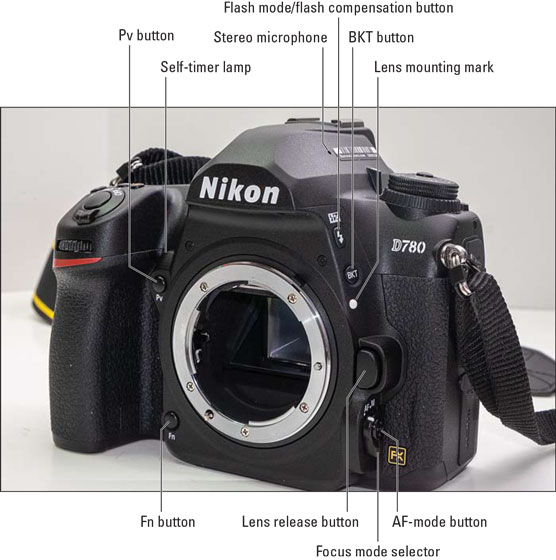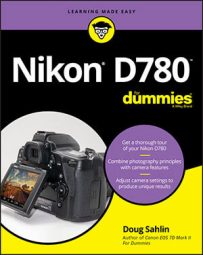 The front of the Nikon D780.
The front of the Nikon D780.Nikon D780 shooting modes
You can do some pretty amazing things with your Nikon D780. You have lots of control over the camera to create awesome pictures. Here’s what each setting on the mode dial is used for (the setting is parenthetically listed to the right of the mode name):
- Auto (Auto): The camera’s point-and-shoot mode. The camera chooses the shutter speed, aperture, and ISO needed to properly expose the
- Programmed auto (P): The camera chooses the shutter speed and aperture needed to properly expose the You can shift the exposure to change the shutter speed and aperture combination to suit the type of scene you’re photographing.
- Aperture-priority auto (A): You choose the aperture (f-stop value), and the camera provides the shutter speed needed to properly expose the
- Shutter-priority auto (S): You choose the shutter speed, and the camera provides the aperture (f-stop value) needed to properly expose the
- Manual (M): You manually choose the shutter speed and aperture. You can also set the shutter speed to bulb or time for long exposures.
- EFCT: This is the camera’s special effects mode. Some effects have options that can be edited in live view.
- U1 and U2: You can apply your own settings to these buttons.
Nikon D780 metering modes
You can choose how the Nikon D780 meters a scene to determine the exposure. Your camera’s metering device examines the scene and determines which shutter speed and f-stop combination will yield a properly exposed image. Your D780 has the following metering modes:
- Matrix metering: Use this metering mode for most subjects to create natural looking images. This metering mode is great for photographing landscapes and architecture. Use this metering mode when the scene you’re photographing is evenly lit.
- Center-weighted metering: Use this metering mode when your center of interest is in the middle of the frame.
- Spot metering: Use this metering mode when your subject is backlit, or your subject is brighter or darker than the background, to avoid washing out your subject. This metering mode meters a small area of the frame.
- Highlight-weighted metering: Use this metering mode when you’re photographing a subject and you need to preserve detail in the highlights (for example, when photographing a singer illuminated by spotlights on a stage).
Your Nikon D780 post-shoot checklist
When you grab your camera bag and head out for a photo shoot, always have the camera at its default settings, a formatted memory card, and a battery that is capable of capturing a few hundred images.
The best time to make sure your camera is ready for the next photo shoot is after you finish the previous one. After you finish a photo shoot, follow these steps to make sure your camera is ready for the next photo shoot:
- Remove the memory card from the camera and download the images to your computer.
- Back up your image files to an external hard drive.
- Reformat the card in the camera (not on your computer).
- Check the life of the battery. If the battery has less than 30 percent of its charge remaining, recharge the battery.
- Set the ISO to 100.
- Set the exposure compensation to 0.
- Make sure the camera-metering mode is set to matrix metering.
- Clean any debris off the camera body. This is especially important if you’ve been shooting at the beach on a windy day.
- Clean the lenses you used.
- Put everything back in your camera bag or camera case.
How to create a tripod for your Nikon D780
Your Nikon D780 can capture images in very low-light conditions. However, at times, you absolutely can’t do without a tripod. But what do you do when you’ve left home without one? Here are some ways you can steady your camera without a tripod:
- Switch to live view mode and place the camera near the edge of a table. If you can see the tabletop in the viewfinder or on the tilting monitor, move the camera closer to the
- Hold the camera against a wall. Use this technique when you rotate the camera 90 degrees (also known as portrait orientation).
- Lean against a wall and spread your legs slightly. This is known as the “human ” Press the shutter-release button gently when you exhale.
- Use a small beanbag to steady the camera. Place your camera on the beanbag and move it to achieve the desired composition. You can purchase a beanbag at your local camera store and keep it in your camera bag so you have one when you need it. As an alternative to the bean bag, you can use a resealable plastic bag filled with uncooked rice (cooked rice is messy and will spoil). Place your camera on the bag and move it until you achieve the desired
In addition to using one of these techniques, use the self-timer. This gives the camera a chance to stabilize from any vibration that occurs when you press the shutter-release button.

